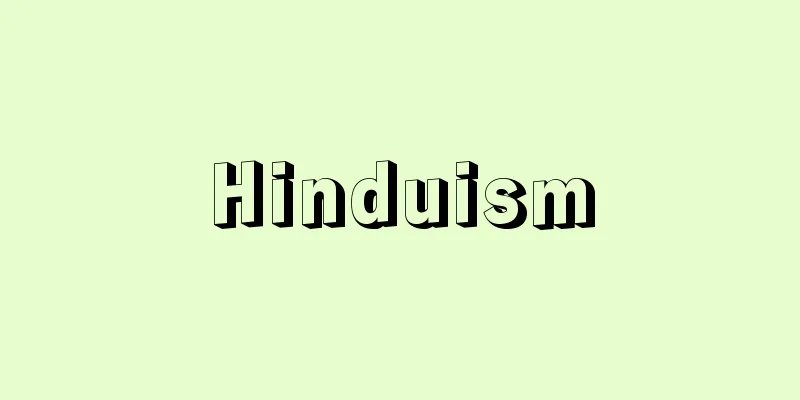Hinduism

|
One of the religions practiced in India. Sometimes called Hinduism. Originally, it was a convenient name for a complex of religions and cultures, and it is impossible to give a precise definition. "Hindu" is a Persian word that originated from the name of the Indus River, and originally meant "people living in the Indus River basin," but later came to mean "Indian." This was adopted into English and other languages, and the word Hinduism was created to refer to Hindu religion and culture. Hinduism is the Japanese translation of this word. [Maeda College] AttributesIn the broad sense, Hinduism includes Brahmanism, but the term Hinduism is sometimes used to distinguish it from Brahmanism. In this case, Brahmanism refers to the religion that developed before the rise of Buddhism, centered on the Brahmin class, and was based on the Vedic scriptures. On the other hand, Hinduism refers to the form that Brahmanism took when the framework of Vedic culture collapsed in the 6th to 4th centuries BC, and Brahmanism absorbed indigenous folk beliefs and other elements, resulting in a major transformation. However, the two are not completely separate. Hinduism is a polytheistic religion with no specific founder and an unclear origin; it formed naturally, and it has a large social customary character that is fused with religious ideas and rituals. It is generally considered an ethnic religion, but some scholars deny this because it has spread beyond India and India itself is a world comparable to Europe. Hinduism is an incredibly inclusive religion, incorporating everything from an extremely developed philosophical system to the most primitive beliefs and magic. It also includes the caste system, the ashram (stage of life) system, and other systems, laws, and customs that govern all aspects of human life. Hinduism goes beyond the concept of a "religion." [Maeda College] HistoryThe Indus Valley Civilization flourished from 2300 to 1800 BC with its two main bases of Mohenjo Daro and Harappa in present-day Pakistan. However, around 1500 BC, the Aryans entered Northwest India, settled in the Punjab (Five Rivers) region, and compiled the sacred text, the Rig Veda, around 1200 BC. The major Vedas were compiled by around 500 BC, and Brahmanism reached its zenith. However, around 500 BC, as a result of a major social upheaval, the framework of Vedic culture collapsed, and anti-Brahmanic free thinkers emerged, leading to the establishment of Buddhism and Jainism. Around the 2nd century BC to the 3rd century AD, when Buddhism was the mainstream in the religious and ideological world, Brahmanism absorbed various elements of indigenous non-Aryan folk beliefs and customs, and underwent a major transformation, leading to the establishment of Hinduism. Although Hinduism is based on Brahmanism, the Hinduism we see today was formed through the following processes: (1) the compilation of unique scriptures and the establishment of various philosophical systems (from around B.C. onwards), (2) the establishment of sects (from the 1st and 2nd centuries A.D. onwards), (3) the popularity of strong Bhakti (devotion) ideas (from 600-800), (4) the formation of Tantrism (from the 7th century onwards), (5) the penetration of Islam (from the 13th century onwards), and (6) British rule, the spread of Christianity, and contact with Western civilization (from 1800 onwards). According to the 1971 census, Hindus make up 82.72% of the total population of the Republic of India (453.29 million people). India is a secular state, but in Nepal, where the majority of the population is also Hindu, Hinduism was the state religion until 2006. There are 2 million Hindus on the Indonesian island of Bali, and in Sri Lanka, Hindus make up 18% of the total population (approximately 2.77 million people). [Maeda College] ScriptureThe oldest of the sacred texts are the Vedas. Hindus recognize the absolute authority of the Vedas and call them "divinely revealed scriptures," but this is nominal, and not all Hindus have always revered them as equally absolute. Although they do not have a scripture with the same absolute authority as the Quran or the Bible, they have compiled a huge number and volume of scriptures. The scriptures that are given the second highest authority after the divinely revealed scriptures are the "ancient texts," which include the following: (1) The two great national epics of India, the Mahabharata and the Ramayana. The Bhagavad Gita, which is the most beloved and revered work today, is part of the former. (2) The Puranas, the sacred texts that serve as a sort of encyclopedia of Hinduism for the general public. (3) Numerous legal codes, including the Laws of Manu. There are many other important documents. One of them is the numerous philosophical documents that show the most advanced philosophical speculation in Hinduism. In addition, the "Samhita", "Agamas", and "Tantras", which are the foundational scriptures of various Hindu sects from the Middle Ages onwards, with Vaishnavite, Shaivite, and Tantristic characteristics, respectively, were compiled. All of these documents were written in the elegant language of Sanskrit (Sanskrit), but there are also many scriptures written in other languages. [Maeda College] GodsIn Hinduism, objects of worship range from powerful gods to mountains, rivers, plants, and trees, and these have also changed over time. For example, the brave god Indra (known as Taishakuten in Buddhism), and the god of justice Varuna (Suite), who were influential during the time of the Rig Veda, lost their influence in the following period. Today, the gods worshipped throughout India in Hinduism are Vishnu and Shiva. Hinduism has developed around three central deities, including Brahma (Bonten). However, Brahma has not been able to gain influence since the Middle Ages. Of these, Vishnu was originally a sun god and has been one of the main deities since the great epics. He is said to be married to the goddess Lakshmi (the heavenly goddess of good fortune), and to appear in ten incarnations to save mankind. The most important incarnations are Krishna and Rama, and the founder of Buddhism, Buddha (Shakyamuni), is also considered to be his ninth incarnation. Shiva originated from Rudra, the god of storms, and as the destroyer, Shiva is feared as Mahakala the Time (known as Daikokuten, one of the Seven Lucky Gods in Japan), who destroys everything, but on the other hand, he is worshipped as a god who bestows blessings. He married the beautiful goddess Parvati, and had two sons, Ganesha (known as Shoten in Japan) and Skanda (known as Idaten in Japan). He is in charge of reproduction and is worshipped in the form of a cylindrical phallic linga. Although Hinduism is essentially polytheistic, it is sometimes asserted that Vishnu and Shiva are merely different names for the same god, and furthermore, the theory of the "Trinity" is expressed, which states that the supreme principle of the universe created Brahma, maintained Vishnu, and destroyed Shiva. Goddesses have been worshipped since ancient times, but they only became important in the Middle Ages when Tantrism became popular. Parvati is particularly influential, and is also called Durga (the unapproachable one) and Kali (the black woman). Many other gods are worshiped, including some that are worshiped in Japan, such as Sarasvati (Benzaiten). Also, we cannot overlook the worship of demigods and half-men such as yakshas and gandharvas, animals such as cows and monkeys, snakes such as shesha, plants such as the Ashvatta tree and Tulasi, mountains such as Mount Kailasa, rivers such as the Ganges, holy places such as Varanasi, and spirits such as Bhut. [Maeda College] SectIn Hinduism, different sects emerged as groups dedicated to different deities. Most sects belong to two groups: Vaishnavism and Shaivism. Another important group is Shaktiism, which can be considered a special development of Shaivism. (1) Vaishnavism worships the god Vishnu as its chief deity. Among them, the Madhva, Ballabhacharya, and Chaitanya sects belong to the Bhagavata sect. The Srivaishnava, Ramananda, and Kabir sects are descended from the Pancharatra sect. Sikhism is also an extension of this sect. (2) Shaivism worships Lord Shiva as its chief deity, and includes the Kapalika sect and the Shaivite sect. (3) Shaktism refers to the active force of the goddess Durga or Kali as Shakti (sexual power) and preaches salvation based on it. However, in the case of Hinduism, the term sect is vague and does not qualify as an organized religious organization or church. From around the 16th century, there was a movement in Hinduism towards fusion with Islam and religious reform, leading to the establishment of Kabir and Sikhism. In 1858, India became a direct colony of Britain, and with contact with Christianity and Western thought and culture, a major upheaval occurred again in Hinduism from the 19th to the 20th century, known as the religious reform or renaissance, and organizations such as the Brahma Society, the Arya Society, the Ramakrishna Mission, and the Sri Narayana Dharma Society were founded. [Maeda College] Doctrine and PracticeIn Hinduism, all kinds of ideas and doctrines are taught, and often even contradictory ideas and doctrines, all of which are Hindu doctrines, and there is no severe conflict or struggle between orthodoxy and heresy, which is often seen in other religions. For this reason, it is extremely difficult to give an overview of its doctrines, but I would like to focus only on the ideas that are central to Hinduism and are considered to be as widely accepted as possible. [Maeda College] View of the UniverseThere are various theories about the creation of the universe. Some say that the absolute Brahman created the universe for play (lila), while others say that this phenomenal world is a manifestation of Brahman's illusory power (maya) and is not actually real, but that only Brahman exists. The earth in the middle of the universe is a disk with Mount Meru at its center, and has seven continents and seven seas. The continent with Mount Meru towering in the middle is called Jambu-Dvipa, and its important part is Bharata-Varsha, or India. This universe lasts for one day of Brahma (Brahma), that is, one kalpa (4.32 billion years on earth), and at the end of the day the universe returns to Brahma again. The universe repeats creation and destruction with each kalpa. One kalpa corresponds to 1,000 Maha Yugas, which consist of four periods, with later periods seeing a decline in human faith and morality compared to previous periods. We are currently in the Kali period, a dark age that began in 3102 BC, and it is said that the great destruction of the universe will occur at the end of this period. [Maeda College] Karma and reincarnationHumans do not return to nothingness when they die, but rather obtain a new body in the next life due to their own deeds. In this way, the cycle of birth and death repeats infinitely. This is reincarnation. Karma is a translation of the Sanskrit word karman, which means action. Every action accumulates as karma, and karma does not disappear until the person who performed it has fully experienced the rewards of that action. The idea of karma and reincarnation first took a clear form in the Upanishads and became a core doctrine in Hinduism, but it is fundamentally different from fatalism and determinism, which deny human free will. [Maeda College] DharmaDharma in Sanskrit has many meanings, such as custom, duty, and doctrine, but simply put, it is a code of conduct. Hinduism has a set of legal codes that compile Dharma, but the central issues are the code of lineage and the code of life. The code of lineage is the code imposed on each of the four classes (varnas): Brahmins, royalty, commoners, and slaves. The code of life is the code prescribed for each of the four periods of life: student, householder, forest dweller, and wanderer. Each person is encouraged to practice the code prescribed for their lineage and the period of life they belong to, without considering the success or failure of things or their interests, and without selfishness. The practice of Dharma is considered to be one of the four great goals of Hindu life, along with materialistic gain (artha), which pursues material and economic gains, passion (kama), which pursues love and sexual love, and liberation (gedatsu), which will be explained next. [Maeda College] LiberationEven if dharma, material gain, and love are realized, the best one can achieve is a birth in heaven, and one will remain in the cycle of reincarnation. The Upanishad thinkers therefore went further and pursued total freedom from karma and reincarnation, that is, moksha, and considered moksha to be the highest goal of life. Three paths were preached as a way to achieve this: the path of action, the path of knowledge, and the path of devotion (bhakti). The path of devotion to God in particular is practicable for everyone, and it developed into a major religious movement around the 7th and 8th centuries and continues to this day. The issues of karma, reincarnation, and moksha were not only urgent issues for ordinary Hindus, but also important issues for thinkers. Although the circumstances differed, six representative philosophical systems (six schools of philosophy), including the Samkhya school that forms the pinnacle of Hinduism, were established and theoretically and systematically investigated moksha and its methods. In particular, the Vedanta school, which is based on the Upanishads, has formed the mainstream of Indian thought and is the representative philosophy of modern Indian intellectuals. [Maeda College] Rituals and festivalsIdol worship is widespread in Hinduism, and every morning people bathe in rivers or reservoirs and worship statues of gods such as Shiva before eating. Rituals involve the use of prayer beads, chanting of mantras (divine songs), and sometimes enthusiastic singing of bhajans, which are similar to hymns. Hindus also worship holy places and make pilgrimages to these places. Symbolic and mystical figures called yantras are used in rituals, and the swastika is used as a svastika (sign of happiness), and sometimes circular areas called mandalas are set aside for rituals. Among the rituals, the approximately 40 samskaras (rites of passage) that must be performed throughout an individual's life are particularly important, including birth festivals, initiation ceremonies at which boys officially become members of Hindu society, weddings, and funerals. There are many festivals held throughout the year, but the main ones include Holi (February-March), a spring festival in honor of various representative deities; Durga Puja (September-October), a festival in honor of Goddess Durga that is popular in Bengal; Dussehra (October), which commemorates Prince Rama's defeat of the demon Ravana; and Divari (October-November), a light festival in which lights are lit in honor of Goddess Lakshmi. [Maeda College] "History of Indian Thought" by Nakamura Hajime (1967, Iwanami Shoten) ▽ "History of Hinduism" by Nakamura Hajime (World Religious History Series 6, 1979, Yamakawa Publishing) ▽ "Mystery and Reality - Hinduism" by Yamazaki Toshio (World Religions 6, 1969, Tankosha) ▽ "History of Asian Buddhism, India Volumes I and V" edited by Nakamura Hajime, Kasahara Kazuo, and Kanaoka Hidetomo (1973, Kosei Publishing Association) ▽ "Introduction to India" edited by Karashima Noboru (1977, University of Tokyo Press) ▽ "Hinduism" by Maeda Sengaku (included in "World Religions", 1978, Buddhist Missionary Church) ▽ "History of Indian Thought" by Hayashima Kyosho, Takasaki Naomichi, Hara Minoru, and Maeda Sengaku (1982, University of Tokyo Press) ▽ "Indian Religion" by L. Renoux, translated by Teruhiro Watanabe and Minoru Mita (Hakusuisha, Que sais-je)" ▽ "The Dawn of Indian Civilization" by Naoshiro Tsuji (Iwanami Shinsho)" ▽ "Hinduism and Islam" by Matsuo Ara (Iwanami Shinsho) [References] | | | | | | | | | [Additional resources] |The ghats (bathing places) stretch for 5km along the Ganges River in Varanasi, a holy place for Hindus. Believers purify themselves in the holy river Ganges, pray to the sun, and pray for the merits of purification and atonement. Varanasi, India ©Shogakukan "> Bathing in the Ganges Source: Shogakukan Encyclopedia Nipponica About Encyclopedia Nipponica Information | Legend |
|
インドで信奉されている宗教の一つ。インド教といわれる場合もある。本来、宗教・文化の渾然(こんぜん)とした複合体に対する便宜的な呼称であり、正確な定義を与えることは不可能。「ヒンドゥー」Hinduとは、インダス川の名称に起源をもつペルシア語であり、「インダス川の流域の人々」を意味したが、のち「インド人」を意味するに至った。これが英語などにも取り入れられて、ヒンドゥーの宗教・文化をさすのにヒンドゥイズムという語がつくられた。ヒンドゥー教はこの語の邦訳である。 [前田専學] 特質広義のヒンドゥー教はバラモン教をも内に含んでいるが、ヒンドゥー教という語はバラモン教と区別して使用されることがある。この場合には、バラモン教は、仏教興起以前にバラモン階級を中心にベーダ聖典に基づいて発達した宗教をさす。他方、ヒンドゥー教は、紀元前6~4世紀にベーダ文化の枠組みが崩壊し、バラモン教が土着の民間信仰などを吸収して大きく変貌(へんぼう)した形のものをさしている。しかし両者はまったく別のものというわけではない。ヒンドゥー教は多神教であり、特定の開祖をもたず、その起源も明確ではなく、自然に形成されたもので、宗教的な観念や儀礼と融合した社会習慣的性格を多分にもつ。一般に民族宗教といわれるが、インドを越えて伝播(でんぱ)したこともあり、またインドそのものがヨーロッパに匹敵する一つの世界であるなどの理由で、それを否定する学者もいる。ヒンドゥー教は、途方もないほどの包摂力をもち、極度に発達した哲学体系から、もっとも原始的な信仰や呪術(じゅじゅつ)をもそのなかに取り込んでいる。そのうえに、カースト制度やアーシュラマ(生活期)制度をはじめ、人間生活の全般を規定する制度、法制、習俗などを内包している。ヒンドゥー教はおよそ「宗教」という概念を逸脱している。 [前田専學] 沿革インダス文明が現在のパキスタンの領内にあるモヘンジョ・ダーロとハラッパーを二大拠点として紀元前2300~前1800年を中心に栄えていた。しかし紀元前1500年ころアーリア人が西北インドに進入、パンジャーブ(五河)地方に定着し、紀元前1200年を中心に聖典『リグ・ベーダ』を編纂(へんさん)した。その後、紀元前500年ころまでに主要なベーダが編纂され、バラモン教の全盛時代を迎えた。しかし紀元前500年ころ、社会的大変動の結果ベーダ文化の枠組みが崩壊して反バラモン教的自由思想家たちが輩出し、仏教やジャイナ教が成立した。仏教が宗教・思想界の主流をなしていた紀元前2~後3世紀ころ、バラモン教が土着の非アーリア的民間信仰・習俗などの諸要素を吸収し、大きく変貌を遂げてヒンドゥー教が成立した。ヒンドゥー教はバラモン教を基盤としてはいるが、(1)固有の聖典の編纂と哲学諸体系の成立(紀元前後以降)、(2)宗派の成立(紀元1~2世紀以降)、(3)強いバクティ(信愛)思想の盛行(600~800年以降)、(4)タントリズムの形成(7世紀以降)、(5)イスラム教の浸透(13世紀以降)、(6)イギリスの支配、キリスト教の伝播、西洋文明との接触(1800年以降)、などの過程を経て、今日みられるヒンドゥー教が形成された。 1971年の国勢調査によると、インド共和国のヒンドゥー教徒は総人口の82.72%(4億5329万人)に達しているという。インドは世俗国家であるが、同じく国民の多数がヒンドゥー教徒であるネパールでは2006年までヒンドゥー教を国教としていた。インドネシアのバリ島では200万のヒンドゥー教徒がおり、またスリランカではヒンドゥー教徒が総人口の18%(約277万人)を占めている。 [前田専學] 聖典聖典中最古のものはベーダである。ヒンドゥー教徒はベーダに対して絶対的な権威を認めて「天啓聖典」とよぶが、それはいわば名目的であって、すべてのヒンドゥー教徒がつねに等しく絶対的なものとして尊崇してきたわけではない。コーランやバイブルほどの絶対的権威をもつ聖典をもたないが、膨大な数と量の聖典を編纂した。天啓聖典に次ぐ権威を与えられている聖典に「古伝書」があり、次のようなものを含む。 (1)インドの国民的二大叙事詩『マハーバーラタ』と『ラーマーヤナ』。今日もっとも愛唱・尊崇されている『バガバッド・ギーター』は前者の一部である。 (2)一般大衆のヒンドゥー教に関するいわば百科事典ともいえる聖典『プラーナ』。 (3)『マヌ法典』をはじめとする多数の法典。 このほかにも重要な文献が数多く存在している。その一つは、ヒンドゥー教のもっとも高度な哲学的思弁を示す多数の哲学的諸文献である。また「サンヒター」「アーガマ」「タントラ」という、それぞれビシュヌ派的、シバ派的、タントリズム的性格をもつ、中世以降のヒンドゥー教の各宗派の基盤となる聖典も編纂された。これらのものはすべて雅語であるサンスクリット語(梵語(ぼんご))で書かれた文献であるが、それ以外のことばで書かれた聖典も数多く存在している。 [前田専學] 神々ヒンドゥー教では、強大な勢力をもつ神々から、山川草木に至るまでが崇拝の対象になり、また時代によっても変遷がある。たとえば、『リグ・ベーダ』の時代に有力であった武勇神インドラ(仏教で帝釈天(たいしゃくてん))や司法神バルナ(水天)などは、次の時代には勢力を失った。今日のヒンドゥー教でインド全域にわたって崇拝されている神はビシュヌ神とシバ神とである。ヒンドゥー教はこのほかにブラフマー神(梵天(ぼんてん))を加えた三つの神格を中軸として発達してきた。しかしブラフマー神は中世以降勢力を得ることができなかった。そのうちビシュヌ神は元来太陽神で、大叙事詩以来主要神格の一つとされ、女神ラクシュミー(吉祥(きちじょう)天女)を妃とし、10種の化身(けしん)を現して人類を救済するという。もっとも重要な化身はクリシュナとラーマで、仏教の開祖仏陀(ぶっだ)(釈迦(しゃか))も、その9番目の化身とされている。シバ神は暴風神ルドラを起源とし、破壊者としてのシバ神は、いっさいを破壊する時間マハーカーラ(日本では七福神の一つである大黒天)として恐れられ、他方では恩恵を与える神として崇拝される。美しい女神パールバティーを妃とし、ガネーシャ(日本で聖天(しょうてん))とスカンダ(日本で韋駄天(いだてん))という息子をもつ。生殖をつかさどり円筒形の男根リンガの形で崇拝される。 ヒンドゥー教の本質は多神教であるが、ビシュヌ神とシバ神とは同一神の別名にほかならないと主張されることもあり、さらにまた、宇宙の最高原理がブラフマー神として創造し、ビシュヌ神としてこれを維持し、シバ神としてこれを破壊するとする「三神一体」の説が表明されることもある。女神は非常に古くから崇拝されてきてはいるが、重要な位置を占めるに至るのはタントリズムが盛行する中世になってからである。とくにパールバティーは有力であり、ドゥルガー(近寄りがたい者)、カーリー(黒女)などともよばれる。そのほか多数の神々が崇拝され、サラスバティー(弁才天)などのように、日本で崇拝されている神々もある。またヤクシャ、ガンダルバなどの半神半人、ウシ・サルなどの動物、シェーシャなどのヘビ、アシュバッタ樹やトゥラシーなどの草木、カイラーサ山などの山、ガンジス川などの河川やワーラーナシなどの聖地、ブートなどの精霊崇拝も見逃すことはできない。 [前田専學] 宗派ヒンドゥー教では、異なった宗派は異なった主神を信奉するグループとして現れた。大部分の宗派はビシュヌ教とシバ教の二つのグループに属する。いま一つの重要なグループとしてシャクティ派(性力派)があるが、これもいわばシバ教の特殊な発展と考えられる。 (1)ビシュヌ教はビシュヌ神を主神とする。そのうち、バーガバタ派の系統に属するものにマドバ派、バッラバーチャーリヤ派、チャイタニヤ派などがある。またパンチャラートラ派の流れをくむものにシュリーバイシュナバ派、ラーマーナンダ派、カビール派などがある。シク教もこの流れの発展したものである。 (2)シバ教は、シバ神を主神とし、カーパーリカ派、シバ聖典派などがこれに属する。 (3)シャクティ派は、女神ドゥルガーまたはカーリーの活動力をシャクティ(性力)と称し、それに基づく救済を説く。 しかしヒンドゥー教の場合には、宗派といっても漠然としたものであり、組織化された教団・教会とよべるほどのものではない。16世紀ころから、ヒンドゥー教に、イスラム教との融合と宗教改革の気運が生じ、カビール道派やシク教などが成立した。1858年インドがイギリスの直轄植民地となり、キリスト教や西洋の思想文物との接触などを契機として、19世紀から20世紀にかけて、ヒンドゥー教にはふたたび宗教改革あるいはルネサンスとよばれる大きな変動が起こり、ブラフマ協会、アーリヤ協会、ラーマクリシュナ・ミッション、シュリー・ナーラーヤナ法普及協会などが設立された。 [前田専學] 教義と実践ヒンドゥー教では、あらゆる種類の、しばしば相矛盾した思想・教義すらも説かれ、そのいずれもがヒンドゥー教の教義であり、他の宗教に往々にしてみられるような正統と異端をめぐる厳しい対立・抗争とは無縁である。このために、その教義を概観することはきわめて困難であるが、ヒンドゥー教にとって中心的であり、かつできる限り広く容認されていると目される思想のみに焦点をあてることにしたい。 [前田専學] 宇宙観宇宙の創造には種々の説がある。絶対者ブラフマンが遊戯(リーラー)のために宇宙の創造を行ったとしたり、この現象世界はブラフマンの幻力(マーヤー)によって現出されたもので、本来は幻影のように実在せず、ブラフマンのみが実在すると説かれることもある。宇宙の中間にある大地は、メール山(須弥山(しゅみせん))を中心とする円盤で、七つの大陸と七つの海をもつ。メール山が真ん中にそびえ立つ大陸がジャンブ・ドゥビーパと称され、その重要部分がバーラタ・バルシャ、すなわちインドである。この宇宙は、ブラフマー(梵天)の1日の間、すなわち1カルパ(劫(こう)、地上の43億2000万年)の間持続し、1日が終わればふたたび宇宙は梵天に帰入する。宇宙は1カルパごとに創造と帰滅を繰り返す。1カルパは1000マハーユガに相当し、1マハーユガは4期からなり、後の期は前の期よりも人間の信仰・道徳性などが低下しており、現在は紀元前3102年に始まった暗黒期であるカリ期にあたり、この期の終わりに宇宙の大帰滅が起こるといわれている。 [前田専學] 業と輪廻人間は死んで無に帰するのではなく、各自の業のために来世においてふたたび新しい肉体を得る。このように生死を無限に繰り返す。これが輪廻(りんね)である。業(ごう)とは、行為を意味するサンスクリット語のカルマンkarmanの訳語。あらゆる行為は業として蓄積され、業は、その行為者がその果報を経験し尽くさない限り消失しない。業・輪廻の思想はウパニシャッドのなかで初めて明確な形をとり、ヒンドゥー教の中核的な教義となったが、本来人間の自由意志を否定する運命論や決定論とは本質を異にしている。 [前田専學] 法(ダルマ)サンスクリット語のダルマは、習慣、義務、教説など多くの意味をもっているが、簡単にいえば行為の規範である。ヒンドゥー教にはダルマをまとめた法典群があるが、その中心的課題は種姓法と生活期法である。種姓法はバラモン、王族、庶民、隷民の4階級(バルナ)のおのおのに課せられた法である。生活期法は学生期、家住期、林棲(りんせい)期、遊行(ゆぎょう)期という人生の4時期のおのおのについて規定されている規範である。各自の生まれた種姓と現に属する生活期に対して規定された法を、事の成否や利害を考慮することなく、利己心を離れて実践することが勧められている。ダルマの実践は、物質的・経済的利益を追求する実利(アルタ)、愛情・性愛を追求する愛欲(カーマ)、および次に説明する解脱(げだつ)とともに、ヒンドゥー教徒の人生の四大目的とされている。 [前田専學] 解脱ダルマ・実利・愛欲はたとえ実現されたとしても、得られる結果はせいぜい天界に生まれることが最高の果報であり、結局、輪廻のなかにとどまっているにすぎない。そこでウパニシャッドの思想家たちはさらに進んで業・輪廻からのまったき自由、すなわち解脱(モークシャ)を追求するに至り、解脱が人生の最高の目的とされた。それを実現する方法として、行為の道、知識の道、信愛(バクティ)の道という三つの道が説かれ、とくに神に対する信愛の道は万人に実践可能であり、7、8世紀ころから大きな宗教運動となって展開し今日に至っている。業・輪廻・解脱の問題は、一般のヒンドゥー教徒にとって切実な問題であったばかりではなく、思想家たちにとっても重要な課題であった。種々事情を異にするとはいえ、ヒンドゥー教の頂点を形成するサーンキヤ学派をはじめとする六つの代表的哲学体系(六派哲学)が成立し、理論的・体系的に解脱とその方法を考究した。なかでもウパニシャッドに立脚するベーダーンタ学派はインド思想の主流を形成し、現代のインドの知識人の代表的な哲学となっている。 [前田専學] 儀礼と祭りヒンドゥー教では偶像崇拝が盛んで、毎朝、川や貯水池などで沐浴(もくよく)してシバ神などの神像を礼拝してから食事をする。儀礼には念珠を用い、マントラ(神歌)が唱えられ、御詠歌に似たバジャンが熱狂的に歌われることもある。ヒンドゥー教徒はまた聖地を崇拝し、聖地巡礼を行う。儀礼にはヤントラという象徴的・神秘的図形が用いられ、卍(まんじ)がスバスティカ(幸福の印)として使われ、儀式を行うためにマンダラと称する一定の円形の場所を設ける場合もある。儀礼のなかでも、個人の一生を通じて行うべきおよそ40にも達するサンスカーラ(通過儀礼)、とくに誕生祭、男子が正式にヒンドゥー社会の一員となる入門式や、結婚式、葬式は重要である。年間に行われる祭りの数は多数に上るが、代表的な諸神を祀(まつ)る春の祭りホーリー(2~3月)、ベンガルで盛んなドゥルガー女神の祭りドゥルガー・プージャー(9~10月)、ラーマ王子が悪魔ラーバナを征伐した記念のダセーラ祭(10月)、灯火をともし、ラクシュミー女神を祀る灯火祭ディバーリー(10~11月)などが主要なものである。 [前田専學] 『中村元著『インド思想史』(1967・岩波書店)』▽『中村元著『ヒンドゥー教史』(『世界宗教史叢書6』1979・山川出版社)』▽『山崎利男著『神秘と現実――ヒンドゥー教』(『世界の宗教6』1969・淡交社)』▽『中村元・笠原一男・金岡秀友編『アジア仏教史 インド編Ⅰ・Ⅴ』(1973・佼成出版会)』▽『辛島昇編『インド入門』(1977・東京大学出版会)』▽『前田専學著『ヒンドゥー教』(『世界の宗教』所収・1978・仏教伝道教会)』▽『早島鏡正・高崎直道・原実・前田専學著『インド思想史』(1982・東京大学出版会)』▽『L・ルヌー著、渡辺照宏・美田稔訳『インド教』(白水社・文庫クセジュ)』▽『辻直四郎著『インド文明の曙』(岩波新書)』▽『荒松雄著『ヒンドゥー教とイスラム教』(岩波新書)』 [参照項目] | | | | | | | | | [補完資料] |ヒンドゥー教徒たちの聖地ワーラーナシのガンジス川沿い、5kmにわたって連なるガート(沐浴場)。信徒は聖河ガンジスで身を清め、太陽に向かって祈り、潔斎や消罪の功徳を願う。インド ワーラーナシ©Shogakukan"> ガンジス川での沐浴 出典 小学館 日本大百科全書(ニッポニカ)日本大百科全書(ニッポニカ)について 情報 | 凡例 |
Recommend
Alpha-converted foods - Alpha-converted foods
...It is convenient as instant rice because it el...
Kamikoshiki [village] - Kamikoshiki
A village in Satsuma District, Kagoshima Prefectur...
Air Car - Air Car
...They are also called ACVs (short for air cushi...
Hunter - Kalyud
(A phonetic change of "karibito") A pers...
Alignements
A type of megalithic monument. It is made up of se...
Syrup - syrup (English spelling)
A general term for thick, sweet liquids. It is ma...
Juraku - Juraku
A Buddhist term referring to the ten joys one can ...
Old Crow
…All of these are thought to date back to 15,000 ...
Kikkou Huguma - Kikkou Huguma
A perennial plant of the Asteraceae family (APG c...
Matsudaira Hirotada
A military commander in the Sengoku period. The e...
Salome
A Russian woman. Her real name was Andreas-Salome....
Rumination
Rumination is the process of regurgitating the co...
Irish Agricultural Organisation Association - Irish Agricultural Organisation Association
…He returned home in 1889 and began to create coo...
Tohimondo - Dialogue between the capital and the countryside
This is the main work of Ishida Baigan, a Shingak...
Big Apple
…After World War II, New York replaced Paris as t...








![Michelin [company] - Michelin](/upload/images/67ccf07a9053c.webp)
